Psoriasis is a non-infectious disease that affects a person's skin, nails, and joints. The disease is characterized by a wavy course with periods of exacerbations and remissions. The danger of this disease lies not only in the unpleasant sensations it causes, but also in the fact that the disease greatly complicates life, interfering with social adaptation and a normal quality of life. In severe cases, severe depression can result from the acute form of the disease.
How to get rid of psoriasis, what is this disease, what are the symptoms and treatment of psoriasis? You will learn this from our article.
Psoriasis: causes
Under normal conditions, the skin of a healthy person renews itself within a month. During this time, dead cells are exfoliated and take the place of new ones. If there is a malfunction in the skin's renewal mechanism, the maturation process of new cells takes only about a week, which disrupts the cellular balance. As a result, the cells die much faster.
In the areas affected by the disease process, there is an excessive proliferation of cells of the immune system, macrophages and cells of the epithelial tissue. Due to this, exfoliation of the skin and the creation of favorable conditions for the inflammatory process are observed. In addition, the processes of formation of new capillaries are accelerated, which is why the skin at the site of inflammation turns red.
Chronic psoriasis is non-infectious in nature, so the disease is considered non-infectious. This was established in the 19th century, but until now scientists cannot name the exact reason for its occurrence.
Among the reasons that are prerequisites for the development of the disease, there are:
- Heredity. If a person's parents or close relatives have a predisposition to skin conditions, it is very likely that it will be inherited. This is due to a mutation in certain sections of the DNA that was found among psoriasis patients and a similar mutation found in their loved ones.
- Gene mutations. Violations in the structure of DNA, which affect the violation of skin renewal processes, can not only be inherited, but also manifest themselves in old age in people whose relatives do not suffer from psoriasis. The causes of these genetic changes are unknown.
- Weakening of the immune systemAny violation of the body's defenses can become a trigger for the development of psoriasis.
- Disruptions in metabolic processes. Metabolic disorders manifest themselves in the form of changes in the metabolism of fats, nitrogen, carbohydrates and vitamins in psoriasis. As a result, there is an accumulation of toxins in the body, a decrease in adaptability and an increased susceptibility to infections. In addition, patients have an increase in the fractions of bile acids in the blood serum, which is caused by metabolic disorders.
- External stimulus. Friction, constant contact with chemical compounds, tight clothing, cuts and insect bites - all this causes the appearance of microtraumas on the skin, which over time can turn into psoriasis.
- Frequent allergic reactions. If a person has a tendency to atypical reactions of the immune system, manifested in the form of rashes, itching and rashes, this is an additional possibility of contracting psoriasis.
- Strong experiences or prolonged stressful situations. Any stress causes a weakening of the body's defenses and undermines the immune system. If a person has a tendency to skin diseases, it can manifest itself at precisely such moments. In addition, any stress affects the endocrine processes, due to which significant doses of adrenaline and norepinephrine are released into the blood. This process affects metabolic processes and biochemical reactions, becoming a prerequisite for the development of psoriasis.
- General weakening of the body caused by serious pathologies: atherosclerosis, liver cirrhosis, diabetes, hypertension, etc.
- Unbalanced diet and alcohol abuse. If a person eats too many fatty, smoked, salty, sweet and spicy foods, the likelihood of developing psoriasis increases. Also, in some cases, a prerequisite for the development of the disease is the excessive consumption of chocolate and citrus.
- Hormone spikes caused by severe changes in hormone levels during menopause, puberty, pregnancy, breastfeeding, after abortion. It is worth noting that the hormonal cause of psoriasis may not be related to the above periods. In this case, we are talking about changing the functioning of the organs of the endocrine system.
- Climate change, living in unfavorable environmental conditions. If a person is prone to psoriasis and moves to a colder area, the disease can worsen significantly. The same applies to staying in areas with highly polluted air and water. However, the climatic factor can hardly be called the root cause of the disease: rather it acts as a catalyst that activates the "dormant" form of the body's tendency to psoriasis.
How to determine if it is psoriasis: symptoms of the disease
First of all, psoriasis is a skin condition. However, in some particularly severe cases, it can affect not only the skin, but also the tendons, internal organs, spine, nails and joints. Below we will look at the signs of psoriasis that appear first and allow us to distinguish psoriasis from other skin conditions.
How does psoriasis start?
On the surface of the skin (most often on the knees, hands, elbows, back, armpits, under the breast, in the region of the sacrum, on the genitals) and sometimes on the mucous membranes, rounded dry reddened areas appear. Initially, their size is relatively small: each papule is only a couple of millimeters in diameter. However, over time, the affected areas increase, the papules merge with each other and form the so-called psoriatic plaques: their diameter reaches 10 cm and even more.
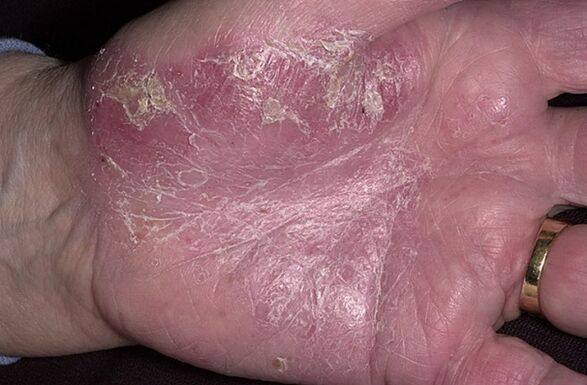
Initially, the papules do not cause noticeable discomfort to a person. Virtually not itchy or itchy. However, over time, as plaque builds up and builds up, the affected areas thicken and rise slightly above healthy areas of the skin. This phenomenon is accompanied by itching.
A feature of psoriasis in the initial stage is the formation of small dry scales with a loose structure on the affected areas of the body. Their color varies from whitish to yellowish-gray, and a thin pinkish-red border can be seen around each plaque. Outwardly, these areas are a bit like melted paraffin, so they are called "paraffin lakes".
At first, the signs of psoriasis on the skin of the body and face can be confused with manifestations of eczema or other skin pathologies. The stage of psoriasis, the so-called psoriatic triad, helps to identify the type of disease.
- Stearic staining phase. It is characterized by the formation of characteristic stearin-like chips, which appear when the plaque is scraped off.
- Terminal film stage. It appears as a smooth, moist and shiny red surface that is found under the scales.
- "Blood dew" phase. If a person begins to scrape off the terminal film, small droplets of blood form on its surface, caused by a pinpoint hemorrhage. In turn, it is caused by the thinning of the vascular network and the fragility of the capillaries.
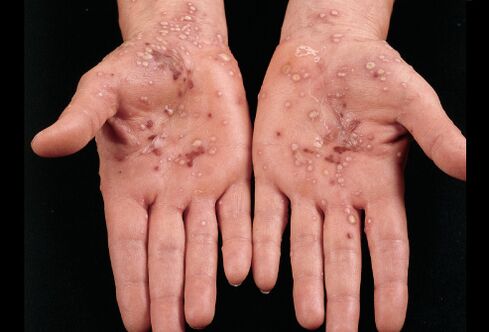
The onset of psoriasis is also accompanied by symptoms not related to the skin. Usually, patients complain of increased fatigue, apathy, irritability, drowsiness, mood swings, dizziness, nausea, and sleep disturbances.
How does psoriasis manifest itself, in addition to skin lesions?
This disease affects not only the skin, but also other organs and systems. The following manifestations and forms of psoriasis are distinguished:
- Psoriatic arthritis. In some cases, the lesion is localized not in the upper areas of the skin, but much deeper. As a result, the disease spreads to the joints. The course of the disease is in many ways similar to the development of rheumatoid arthritis, but there are a number of differences between them. For example, in psoriatic arthritis, asymmetrical joint damage is usually observed, the maximum peak of discomfort occurs in the morning, but the main difference is that rheumatoid factor is absent in the blood of patients with psoriatic arthritis.
- Muscle damage. If the disease is in an extremely advanced stage, muscle tissue atrophy can occur after damage to the cartilage and joints.
- Liver dysfunction. The task of the liver is to purify the blood and remove harmful substances. If there is an increase in the content of toxins in the body, which is characteristic of psoriasis, the liver suffers from it in the first place.
- The transition of the disease from the skin to the mucous membranes. If the disease is not treated, it progresses and passes to the mucous membranes of the cheeks and genitals, lips and tongue. Mucous membranes swell, foci of inflammation appear, accompanied by peeling.
- Nail damage (psoriatic onychodystrophy). Psoriasis affects the nails quite often. The disease manifests itself in the form of thickening of the nails on the hands and feet, a change in their color, the appearance of furrows and spots on them. Inflammatory processes affecting the skin around the nails, bleeding under the nail plate, dryness, delamination and increased brittleness of the nails can also be observed. In particularly severe cases, we can talk about complete detachment of the nail and its loss.
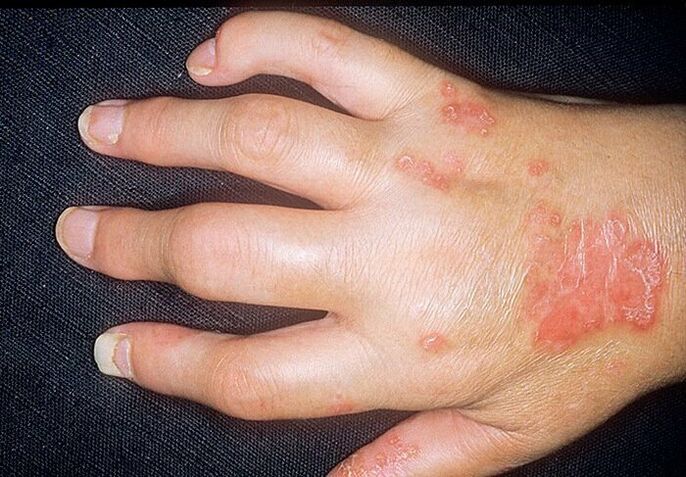
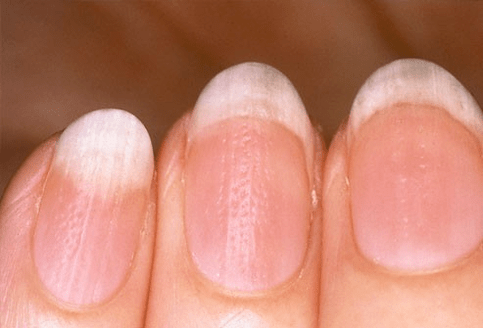
As you can see, this disease is quite dangerous, so its treatment should be started as soon as possible to prevent its transfer to other organs and systems.
Is psoriasis contagious?
Since the disease is non-infectious and non-viral in nature, it is not contagious at all. The only way of transmission of the disease is a genetic predisposition caused by heredity.
Types of psoriasis
There are several varieties of this disease, each of which has its own characteristics of the course and characteristic symptoms.
- Simple / vulgar / plaque / plaque / common. According to the international classification of diseases - prosiasis vulgaris. This form is more common than others: in about 80-90% of cases of the disease, it is psoriasis vulgaris. It is characterized by the appearance of "paraffin lakes" or psoriatic plaques.
- Inverse (inverse psoriasis). This type of disease mainly affects the skin folds, the outer surface of the thighs, the groin area with the external genitals. The main difference between inverse psoriasis and vulgar psoriasis is that with the inverse form of the disease, plaques do not form on the skin - the skin becomes covered with red spots, accompanied by an inflammatory process. The danger of inverse psoriasis is that it progresses with sweat and friction. Due to this, microcracks are formed on the skin, into which the infection enters. As a result, it can lead to skin lesions with cocci and fungi.
- Drop-shaped (according to ICD - guttate psoriasis). Its difference from other varieties is that the teardrop-shaped rash with psoriasis does not combine into large plaques. The patient's body is covered with small drop-like spots (hence the name of the disease), the color of which varies from pink to purple.
- Pustular / exudative. If other types of the disease are characterized by dry areas of the skin, pustular or exudative psoriasis can be recognized by weeping blisters filled with a clear liquid. In this case, the skin around the blisters usually turns red, the local temperature rises. If the blisters burst or if the patient combs them, there is a danger of infection and subsequent suppuration - this is the main danger of the pustular form of the disease.
- Psoriatic erythroderma. This is one of the most severe forms of the disease, which, if the course is unfavorable, can lead to the death of the patient. Its distinctive feature is skin exfoliation, as a result of which a pathogenic microflora infection can occur. The first sign and symptom of this type of disease - psoriasis manifests itself in the form of severe itching of the skin, small red rashes with white scales, swollen lymph nodes, swelling of tissues and an increase in overall body temperature to 38-39 degrees. It is divided into generalized and hyperergic types.
- Seborrheic psoriasis. Most often, this type of disease affects the scalp, but in some cases it can involve the nasolabial folds, the skin near the auricles, and the area of the shoulder blades. It is characterized by the appearance of dandruff (when localized on the head), severe itching and a grayish bloom.
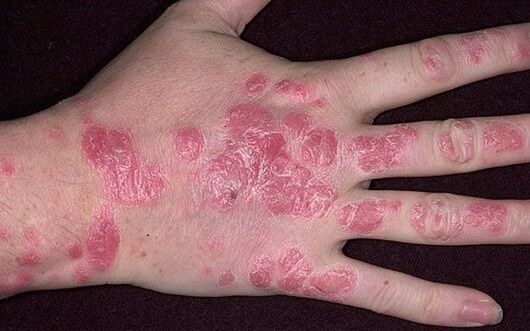
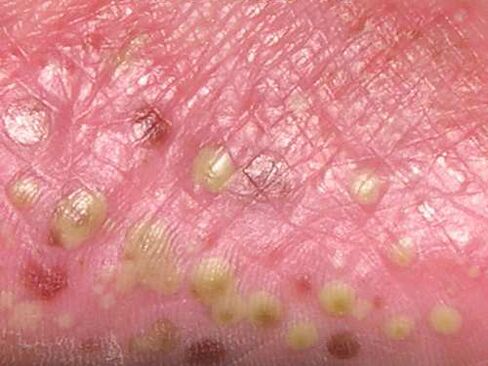
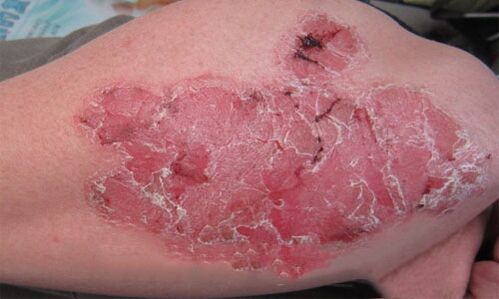
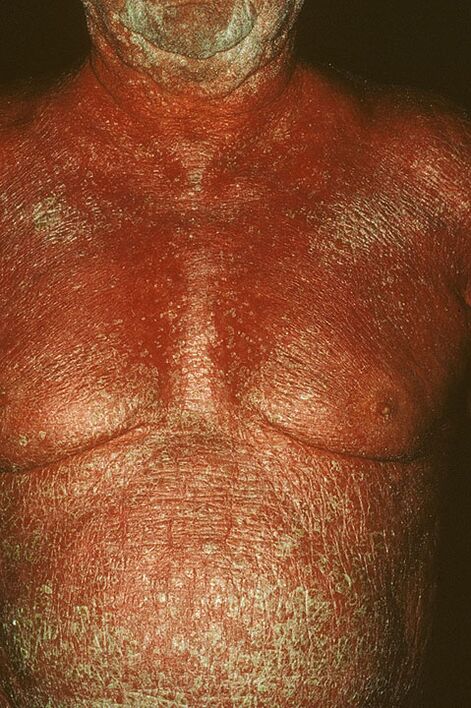
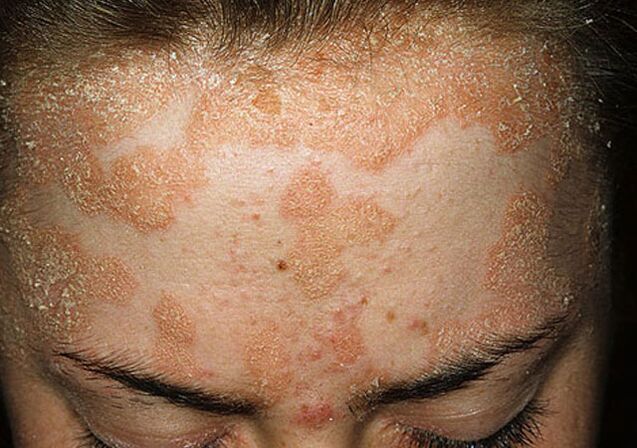
Exacerbation of psoriasis
The disease is characterized by a chronic wavy course with periods of exacerbations and remissions. A decrease in the intensity of symptoms is usually observed in the warm season, while the disease worsens in winter and autumn.
Factors provoking an exacerbation of the disease can be:
- Stress, anxiety.
- Unbalanced work and rest schedule.
- Weakening of the body after suffering from an infectious or viral disease.
- A sharp jump in hormones.
- Taking some medications.
- Use of unsuitable cosmetics.
- Skin contact with household chemicals.
- Dysfunction of organ systems.
- Exposure to excessively dry, hot or cold air.
- Intensive personal hygiene is not guaranteed.
- Insect bites.
- Exacerbation of allergic reactions.
- Wear tight synthetic clothing.
- Moving to an unusual climate.
The exacerbation of any skin disease (including psoriasis) brings the patient great discomfort, not only physical, but also to a greater extent psychological. The quality of life of a person suffering from severe psoriasis in the acute stage is significantly reduced.
Patients with psoriasis often have significant social adjustment difficulties and problems, which can adversely affect work / school / personal life. A person refuses contact with others, preferring to spend most of his time alone. As a result, he develops social anxiety, which can turn into severe depression over time.
An exacerbation of the disease can lead to the fact that it becomes difficult for the patient to take care of himself and her loved ones, lead a normal life and even sleep. If the rash is localized in the genital area, they can cause physical and psychological discomfort and lead partners to refuse intimacy.
The severity of the disease
Depending on the area of the affected skin and the spread of the injury to the joints, nails and internal organs, a mild, moderate and severe form of the disease is issued.
- The mild form implies minor skin damage, when the total area of the lesion is about 3%.
- The defeat of 3-10% of the human skin is considered an average severity of the disease.
- A severe degree means a significant skin lesion - from 10% or more of the total skin area.
If a patient is diagnosed with damage to the joints, muscles and internal organs, we are talking about a severe form of the disease, even if there are practically no plaques and papules on the body.
How to get rid of psoriasis: treatment
The question of how to cure psoriasis forever is a cause for concern for all people suffering from this disease. The fight against the external manifestations of the disease gives only a temporary result, therefore, in order for the effect to last, it is important to eliminate the causes of psoriasis. This usually takes a long time, up to several years. The patient must be patient, but only in this case can he count on a long-term effect.
Below we see how to treat psoriasis with drugs, hormone therapy, phototherapy, exercise. We also turn to methods of treating psoriasis with folk remedies: in combination with traditional therapy, traditional medicine can give noticeable results.
Treatment of psoriasis with drugs
The first thing to do after experiencing suspicious round rashes, increased dryness and peeling of the skin in yourself or loved ones is to seek qualified medical help. Only a dermatologist can determine exactly what type of skin lesion is occurring in your particular case. Remember: in no case should you self-medicate, as the lack of self-selected therapy or drugs can cause serious harm to your health.
Skin tests or tests are usually not needed to diagnose the disease. It is enough for the doctor to see the skin covered with papules or plaques to establish the cause of the lesion. If there is a severe form of the disease, the dermatologist may prescribe a referral for tests - general and biochemical studies of blood and urine, and in particularly difficult cases, a skin biopsy may also be required. X-rays may also be needed to diagnose psoriatic arthritis.
There are several effective treatments for psoriasis. The choice of the appropriate treatment option depends on the degree of damage to the skin, joints, nails and the intensity of the progression of the disease. Usually, the best option is to opt for a comprehensive treatment regimen that includes the use of local and internal remedies, the use of ultraviolet radiation, salt and soda baths, and physical therapy.
To eliminate itching and peeling of damaged skin, creams, gels, ointments, sprays and lotions are used. They can be prepared on the basis of salicylic acid, pyrithione, tar and other active components. The main task of hormonal and non-hormonal external preparations is to soften psoriatic plaques, disinfect, eliminate inflammation, moisturize and nourish the affected skin areas.
In the role of drugs taken orally in the treatment of psoriasis in humans, there are drugs based on efalizubam, gamma-D-glutamyl-D-tryptophan sodium, etc.
A positive result in the treatment of skin psoriasis gives you a rest by the sea. At the same time, it is advisable to choose locations with a relatively mild and warm climate. The ideal solution is treatment in specialized health and spa facilities, the rest in which it is aimed at the complex therapy of psoriasis.
Psoriasis: home treatment
Treatment of psoriasis with home and folk remedies can be effective only if it acts as an adjunct therapy that complements the main drug treatment. In addition, it is possible to bet on traditional medicine recipes if the patient has allergic reactions to drugs. But in any case, what to do with psoriasis should be decided by the doctor, so if you want to use this or that popular method, be sure to consult a dermatologist.
One of the most common traditional medicines for psoriasis is the use of baking soda. Baking soda has a softening effect on psoriatic plaques, softens rough skin, reduces itching, and improves waste removal. On the basis of soda, homemade ointments are prepared, baths are prepared, soda is taken orally, compresses and lotions are made.
In addition, salt baths are an effective method of curing the disease. They become a valid alternative if the patient does not have the opportunity to go to the sea.
Celandine juice applied to psoriatic plaques also gives positive results. However, it is necessary to remember that this remedy is quite aggressive, so you need to make sure that the juice does not reach the healthy areas of the skin.
Walnut shells are also used to fight psoriatic plaques. The shell is poured with boiling water, after which it is insisted, the resulting infusion is filtered and added to a warm bath. This remedy is especially effective during periods of exacerbation of the disease.
How to cure psoriasis with diet?
Adequate nutrition plays an important role in all skin conditions, and psoriasis is no exception. Of course, a balanced diet may not be a one hundred percent remedy for psoriasis, but in combination with drugs and traditional medicine, it gives good results.
During treatment, in addition to prolonging the period of remission, doctors advise to give up alcohol, smoked and salty foods, fatty and spicy foods, the use of artificial flavors, preservatives, emulsifiers and chemical dyes, fatty meats, mayonnaise, Ketchup. It is also advisable to reduce the amount of salt, refined sugar, chocolate and other sweets and citrus fruits consumed. Doctors advise to focus on using low-fat fermented milk products, plant foods, grains, lean meats and fish.
Despite the fact that during the diet it is desirable to reduce the amount of fat consumed, it is irrational to completely abandon them. You just need to replace animal fat with vegetable oils: olive, linseed, corn, sunflower.
Psoriasis prevention
The stages of psoriasis treatment necessarily include a period of remission. It is important to extend these periods for as long as possible. To do this, the patient must adhere to a number of disease prevention rules:
- Avoid stressful situations.
- Eat a balanced diet.
- Refuse to wear tight-fitting clothes made of wool and synthetic materials.
- Spend enough time outdoors.
- Ensure adequate rest and adequate sleep.
- Take care of your skin.
























